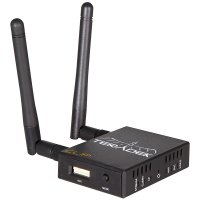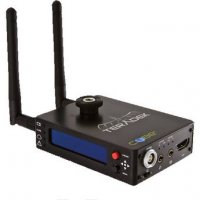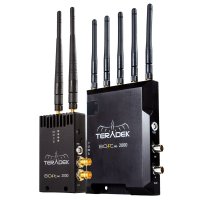Benjamin Rowland
Member
The Teradek Bolt Pro 2000 and Teradek Clip - quick review and comparison
by Benjamin Rowland, Yonder Blue Films
View attachment 17407
View attachment 17408
Bart of MultiRotorForums.com, along with Michael Gailing of Teradek, gave me the opportunity to review the Teradek Bolt Pro 2000 and Teradek Clip to see how they fit into the world of low-altitude HD aerial video. Both products are used for transmitting HD video wirelessly and since they are lightweight, they can be used on multi-rotor helicopters, like the one pictured below.
View attachment 17409
If you’re the type of person that skims through reviews, I’ll let it be known right up front that both of these products are top quality and that Teradek is a company with great customer service and a strong, long-standing reputation in the industry.
If you’re already familiar with these two products, you know that they come in at two very different price points. The Bolt Pro 2000 sells for $7,990 USD ($8,340 as tested in this review). The Clip sells for $599. The reason for the difference in price comes down to features and each of these devices is targeted at a different type of customer. In my opinion, and I think Teradek would agree, the Clip is targeted at hobbyists while the Bolt Pro 2000 is targeted at the working professional (with 15+ years in TV and a passion for flying, I fall into both categories). The feature sets of each are definitely appropriate to each type of customer. Now that’s not to say that the Clip can’t be used on a professional film set as prosumer gear shows up on film sets all the time with the GoPro Hero cameras as a great example.
View attachment 17410
The Clip is the lighter and smaller of the two (66x49x17mm and less than 2 ounces) and could be used on a fairly small multi-rotor. The Clip can take video from your camera via HDMI, compress it using H.264 compression, and then send that HD video wirelessly to your iPad. How new your iPad is will determine the max resolution and bitrate that can be received. An iPad4 tops out at 720p at 3.0Mbps according to their website. I haven’t tested the iPad functionality yet, as I don’t currently own an iPad but as I understand it, you can download a free app for your iPad that will allow you to control the Clip, change settings, and receive the HD video signal. I asked Michael of Teradek if there were other options for receiving the video signal that would allow me to view it on a field monitor because we use a range of monitors in the field, from 7 inch to 21 inch, depending on the shoot. He recommended their Cube 455 decoder (pictured below). This is basically a receiver that can decode that H.264 stream and send it out via HDMI to your monitor. Teradek’s Cube series has a ton of uses, but that’s outside the scope of this review so the question remains, does it work? Yes it does.
View attachment 17411
The Clip uses WiFi to transmit it’s signal so out of the box it can transmit that signal up to 300 feet. If you need more range than that, you can add a router (or routers) that can boost the range substantially. Here’s a video from Teradek that details how that can be done using a router from Ubiquiti.
Based on some quick research, it looks as though the Ubiquiti system they’re recommending could be ordered from Amazon for roughly $250 (router and antenna). For someone needing more than 300 feet of range, this would be a reasonable add-on. Teradek has plans to release their own range extending product as well.
Pairing the Clip with the Cube decoder wasn’t difficult. Teradek has setup videos that make it easy to follow along and get your product up and running. It wasn’t one of those situations where I could just pull it out of the box and it works, but watching the set-up videos made the steps involved go smoothly so it worked as advertised the first time. It basically involves setting up a WiFi network for the two devices to communicate on. The devices each have an IP address that is entered into your computer’s browser which launches the interface for making changes to settings on the devices. Now the Bolt Pro 2000 is pretty different in this regard.
On a professional film set, time is of the essence, and that is where the Bolt Pro 2000 shines (I will abbreviate as BP2000). You pull the BP2000 out of its custom cut Pelican case and it’s obvious that it is built to take the abuse that equipment can be subjected to “on set”. Despite their tough metal casings, the transmitter and receiver are both fairly lightweight (TX: 249g RX: 476g). The size would make this system right at home on a rig built to fly a GH3 or larger (TX: 4.3” x 2.6” x 1.0”). Currently, the BP2000 has only an SDI connector, but Teradek has plans to release an HDMI system. But back to the issue of “time” as that’s the critical thing with this system. Plug in power to the BP2000 TX and RX and you’re up and running. No waiting, no set-up, no instructions necessary – give it power and it just works; you’re getting beautiful, wireless, uncompressed HD video right out of the camera with no waiting! Since the HD signal isn’t compressed, this system could work in a live broadcast. So that’s one important point where the BP2000 and the Clip differ, the Clip uses H.264 compression, and the BP2000 is uncompressed (meaning what you see from your camera’s SDI or HDMI port is what’s transmitted).
View attachment 17412
Without needing to compress the video signal the BP2000 offers a very important advantage over the Clip: almost zero latency. Since the Clip has to compress the video signal at the transmitter and then decode it at the receiver, there’s a small delay. This latency experienced with the Clip doesn’t exclude it from professional use, but it could bring some limitations. Say you wanted to use the system on a typical ground based shoot with a focus puller, the latency introduced would make it pretty much impossible to pull focus using the Clip. The Bolt Pro 2000, on the other hand, with almost zero latency enables the user to pull focus and to use the signal as an FPV feed for the camera operator. And right out of the box the Bolt Pro 2000 has over 2,000 feet of range, hence the name. Here’s a video from Teradek showing off the long range capability of the BP2000.
For all of the products, there are plenty of ways to power them but one feature I found convenient about the BP2000 was the optional battery mount. I chose to test it with the Anton Bauer mount since I own a couple of those batteries, and they worked as expected. These batteries are commonly used to power professional cameras, monitors, and lights.
Clearly, the Bolt Pro 2000 would be right at home in your typical production environment and while the price may seem high at first, it’s actually priced much lower than products in its class while being smaller and lighter. I was describing the system to crew members in the camera department on a recent shoot for a car commercial and their eyes got big as their jaws dropped…..the features of the Bolt Pro 2000 make this a stand-out product in the production industry.
As I said in the beginning, these are both high quality products intended for two different markets but with some overlap in features and utility. This review should help you to decide which of the two systems is right for you but there’s plenty more information on Teradek’s website. Due to some rough winter weather here in Georgia, my experience with these systems was limited but Teradek mentioned that they might be able to send a Bolt Pro 2000 for a more long-term review this Spring. I hope that’s the case as I’m a big fan of the system and I can envision plenty of uses for it both in the air and on the ground. Keep an eye out for more exciting product announcements from Teradek in early April during NAB. I’m betting they’ll have more up their sleeve for our industry - exciting times! (See update below.)
Note: This is an unbiased review. I didn’t receive any compensation from Teradek for this review. All that said, after reviewing their products, I’m a fan.
UPDATE: Teradek just announced updates for the Bolt series. It's now smaller, lighter, and combines HDMI and SDI on one system. They've also added a some other features that could be very useful. Head over to their site for NAB 2014 product announcements.
by Benjamin Rowland, Yonder Blue Films
View attachment 17407
View attachment 17408
Bart of MultiRotorForums.com, along with Michael Gailing of Teradek, gave me the opportunity to review the Teradek Bolt Pro 2000 and Teradek Clip to see how they fit into the world of low-altitude HD aerial video. Both products are used for transmitting HD video wirelessly and since they are lightweight, they can be used on multi-rotor helicopters, like the one pictured below.
View attachment 17409
If you’re the type of person that skims through reviews, I’ll let it be known right up front that both of these products are top quality and that Teradek is a company with great customer service and a strong, long-standing reputation in the industry.
If you’re already familiar with these two products, you know that they come in at two very different price points. The Bolt Pro 2000 sells for $7,990 USD ($8,340 as tested in this review). The Clip sells for $599. The reason for the difference in price comes down to features and each of these devices is targeted at a different type of customer. In my opinion, and I think Teradek would agree, the Clip is targeted at hobbyists while the Bolt Pro 2000 is targeted at the working professional (with 15+ years in TV and a passion for flying, I fall into both categories). The feature sets of each are definitely appropriate to each type of customer. Now that’s not to say that the Clip can’t be used on a professional film set as prosumer gear shows up on film sets all the time with the GoPro Hero cameras as a great example.
View attachment 17410
The Clip is the lighter and smaller of the two (66x49x17mm and less than 2 ounces) and could be used on a fairly small multi-rotor. The Clip can take video from your camera via HDMI, compress it using H.264 compression, and then send that HD video wirelessly to your iPad. How new your iPad is will determine the max resolution and bitrate that can be received. An iPad4 tops out at 720p at 3.0Mbps according to their website. I haven’t tested the iPad functionality yet, as I don’t currently own an iPad but as I understand it, you can download a free app for your iPad that will allow you to control the Clip, change settings, and receive the HD video signal. I asked Michael of Teradek if there were other options for receiving the video signal that would allow me to view it on a field monitor because we use a range of monitors in the field, from 7 inch to 21 inch, depending on the shoot. He recommended their Cube 455 decoder (pictured below). This is basically a receiver that can decode that H.264 stream and send it out via HDMI to your monitor. Teradek’s Cube series has a ton of uses, but that’s outside the scope of this review so the question remains, does it work? Yes it does.
View attachment 17411
The Clip uses WiFi to transmit it’s signal so out of the box it can transmit that signal up to 300 feet. If you need more range than that, you can add a router (or routers) that can boost the range substantially. Here’s a video from Teradek that details how that can be done using a router from Ubiquiti.
Based on some quick research, it looks as though the Ubiquiti system they’re recommending could be ordered from Amazon for roughly $250 (router and antenna). For someone needing more than 300 feet of range, this would be a reasonable add-on. Teradek has plans to release their own range extending product as well.
Pairing the Clip with the Cube decoder wasn’t difficult. Teradek has setup videos that make it easy to follow along and get your product up and running. It wasn’t one of those situations where I could just pull it out of the box and it works, but watching the set-up videos made the steps involved go smoothly so it worked as advertised the first time. It basically involves setting up a WiFi network for the two devices to communicate on. The devices each have an IP address that is entered into your computer’s browser which launches the interface for making changes to settings on the devices. Now the Bolt Pro 2000 is pretty different in this regard.
On a professional film set, time is of the essence, and that is where the Bolt Pro 2000 shines (I will abbreviate as BP2000). You pull the BP2000 out of its custom cut Pelican case and it’s obvious that it is built to take the abuse that equipment can be subjected to “on set”. Despite their tough metal casings, the transmitter and receiver are both fairly lightweight (TX: 249g RX: 476g). The size would make this system right at home on a rig built to fly a GH3 or larger (TX: 4.3” x 2.6” x 1.0”). Currently, the BP2000 has only an SDI connector, but Teradek has plans to release an HDMI system. But back to the issue of “time” as that’s the critical thing with this system. Plug in power to the BP2000 TX and RX and you’re up and running. No waiting, no set-up, no instructions necessary – give it power and it just works; you’re getting beautiful, wireless, uncompressed HD video right out of the camera with no waiting! Since the HD signal isn’t compressed, this system could work in a live broadcast. So that’s one important point where the BP2000 and the Clip differ, the Clip uses H.264 compression, and the BP2000 is uncompressed (meaning what you see from your camera’s SDI or HDMI port is what’s transmitted).
View attachment 17412
Without needing to compress the video signal the BP2000 offers a very important advantage over the Clip: almost zero latency. Since the Clip has to compress the video signal at the transmitter and then decode it at the receiver, there’s a small delay. This latency experienced with the Clip doesn’t exclude it from professional use, but it could bring some limitations. Say you wanted to use the system on a typical ground based shoot with a focus puller, the latency introduced would make it pretty much impossible to pull focus using the Clip. The Bolt Pro 2000, on the other hand, with almost zero latency enables the user to pull focus and to use the signal as an FPV feed for the camera operator. And right out of the box the Bolt Pro 2000 has over 2,000 feet of range, hence the name. Here’s a video from Teradek showing off the long range capability of the BP2000.
For all of the products, there are plenty of ways to power them but one feature I found convenient about the BP2000 was the optional battery mount. I chose to test it with the Anton Bauer mount since I own a couple of those batteries, and they worked as expected. These batteries are commonly used to power professional cameras, monitors, and lights.
Clearly, the Bolt Pro 2000 would be right at home in your typical production environment and while the price may seem high at first, it’s actually priced much lower than products in its class while being smaller and lighter. I was describing the system to crew members in the camera department on a recent shoot for a car commercial and their eyes got big as their jaws dropped…..the features of the Bolt Pro 2000 make this a stand-out product in the production industry.
As I said in the beginning, these are both high quality products intended for two different markets but with some overlap in features and utility. This review should help you to decide which of the two systems is right for you but there’s plenty more information on Teradek’s website. Due to some rough winter weather here in Georgia, my experience with these systems was limited but Teradek mentioned that they might be able to send a Bolt Pro 2000 for a more long-term review this Spring. I hope that’s the case as I’m a big fan of the system and I can envision plenty of uses for it both in the air and on the ground. Keep an eye out for more exciting product announcements from Teradek in early April during NAB. I’m betting they’ll have more up their sleeve for our industry - exciting times! (See update below.)
Note: This is an unbiased review. I didn’t receive any compensation from Teradek for this review. All that said, after reviewing their products, I’m a fan.
UPDATE: Teradek just announced updates for the Bolt series. It's now smaller, lighter, and combines HDMI and SDI on one system. They've also added a some other features that could be very useful. Head over to their site for NAB 2014 product announcements.
Attachments
Last edited by a moderator:







